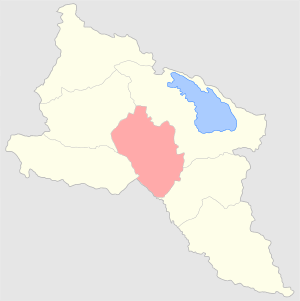Erivansky Uyezd
| Erivansky Uyezd (English) Эриванский уезд (Modern Russian) | |
|---|---|
 | |
| Coat of Arms | |
.png) Coat of arms of Erivan Governorate | |
| Established | 1846 |
| Abolished | 1918 |
| Political status Region |
Uyezd Caucasus |
| Area | |
| Area - Rank |
2,664 verst² n/a |
| Population (1897 census) | |
| Population - Rank - Density - Urban - Rural |
150,879 inhabitants n/a 56.6 inhab. / verst² |
| Government | |
| First Head Last Head | n/a n/a |
Erivansky Uyezd (Russian: Эриванский уезд) was one of the uyezds (administrative units) of Erivan Governorate of the Russian Empire with its center in Erivan (the Armenian capital Yerevan) from 1846 until its formal abolition in 1918.[1]
Geography
Erivan Governorate consisted of Erivansky, Alexandropolsky, Echmiadzinsky, Nakhchivansky, Novobayazetsky, Surmalinsky, and Sharur-Daralagozsky Uyezds.[2] Erivansky Uyezd was located in the central part of Erivan Governorate bordering its Etchmiadzinsky and Surmalinsky Uyezds in the west, Novobayazetsky in the east, and Sharur-Daralagozsky Uyezd in the south. The area of the uyezd was 2,664 square versts (3,032 km2). The northeastern part of the uyezd was mountainous and rocky while the southwestern part consisted of steppes and plains. The southwestern part is watered by Araz River with the lowest altitude of 2,667 ft (813 m) on the border with Shahur-Daralagozsky Uyezd. Erivan lied at 3,200 ft (980 m) above sea level, which was the highest peak of the uyezd. Among the rivers discharging in Araz are Zanga, Garni-chay and Vedi-chay which usually dry out during summers and become active in the winters.[3]
History
The territory of the uyezd had been a part of Erivan Khanate until 1828, when according to Treaty of Turkmenchay, it was annexed to Russian Empire. On December 14, 1846 Erivansky Uyezd was created from within a newly established Tiflis Governorate. On June 9, 1849, a new Erivan Governorate was established from southern parts of Tiflis Governorate and western parts of Shemakha Governorate (later renamed to Baku Governorate), and Erivansky Uyezd became a part of it along with Nakhchivansky, Ordubadsky, and Sharur-Daralagozsky Uyezds which had a predominantly Azerbaijani majority.[2][4] In 1918, the uyezd became part of the First Republic of Armenia.[5] After establishment of Soviet rule in 1920, the territories of the uyezd became part of Armenian SSR and Erivan, renamed to Yerevan, became its capital.[6]
Population
According to census held in 1897, the population of uyezd was 150,879, of which 77,491 were Tatars (modern Azerbaijanis), 58,148 were Armenians, 8,195 Kurds, 3,713 Russians and other minorities.[7] Among 16 rural communities and 205 villages of Erivan Uyezd, Tatars made up the majority of population with 53.5%, while Armenians constituted 37%.[3] The population was engaged primarily in agricultural farming, gardening, winemaking. Approximately 50% of the wine in Erivan Governorate was produced in Erivan Uyezd. According to statistical data, there were 129,120 of great cattle which made up 11% of cattle in the whole governorate.[3]
References
- ↑ Tsutsiev, Arthur (2014). Atlas of the Ethno-Political History of the Caucasus. Translated by Nora Seligman Favorov. New Haven: Yale University Press. p. 24. ISBN 9780300153088.
- 1 2 (Russian) "Административно-территориальные реформы на Кавказе в середине и во второй половине ХIХ века" [Administrative-territorial reforms in Caucasus in middle and second half of 19th century]. Retrieved 2011-08-11.
- 1 2 3 (Russian) "Большой энциклопедический словарь Брокгауза и Ефрона. Эривань" [Brockhaus and Efron Encyclopedia Dictionary. Erivan.]. Retrieved 2011-08-11.
- ↑ (Russian) "Нахичеванская автономная республика" [Nakhichavn Autonomous Republic]. Retrieved 2011-08-11.
- ↑ Tsutsiev, p. 74–76.
- ↑ Tsutsiev, p. 80–82.
- ↑ (Russian) "Первая всеобщая перепись населения Российской Империи 1897 г. Распределение населения по родному языку и уездам Российской Империи кроме губерний Европейской России" [First All Russian Imperial Census of 1897. Population split according to languages spoken; uyezds of Russian empire except for governorates in European part of empire]. Retrieved 2011-08-11.